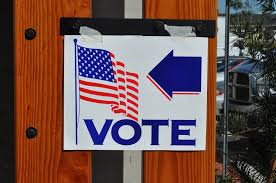Midterm Elections

You may have seen it on the news, heard about it on the radio, or even have read about it in the newspaper. The recently concluded midterm elections brought sweeping changes to the United States Congress. What does that mean? What are the midterm elections? What is a lame duck? In what ways (if any) will American life be different after the Republican’s shellacking of the democrats?
The midterm elections get their name from their position on the calendar. As you probably already know, the government of the United States is split into branches. The executive branch is headed by the President of the United States, who is elected to a term of four years. The legislative branch contains the Houses of Congress:
- House of Representatives- the House of Representatives contains 435 members, with states that have higher populations receiving more representatives. For example, Florida has the third-highest population in America, and has the third-highest number of representatives (27). Representatives from the House face re-election every two years.
- The Senate- the Senate contains 100 members, with two senators per state. For example, Florida would have the same number of senators as Georgia (2). Senators face re-election every 6 years, but it is a bit tricky. One-third of senators face re-election every two years, so every 6 years, all senators have gone through re-election.
That is where the word “midterm” comes from. Whenever a president is elected, so are congressmen and senators. Every even year there is a federal election in the United States (for example, our last federal election was 2012 until this year’s 2014 election). When a president is midway through his term, all 435 congressmen and 1/3 of the Senate is up for re-election, it is an even year, but the president still has two years, or half of his term left.
Now that we are comfortable with what the midterm elections are we can talk about what happened this year.
The United States is largely considered to be a two-party system. This means that there are two political parties that control most of the government. On the center-left of the political spectrum would be the Democratic Party, and on the center-right would be the Republican Party.
Our president, Barack Obama is a Democrat. Members of the Democratic Party generally believe in policies such as the right to have an abortion, higher taxes on people who make more money, higher minimum wage, legalization of gay marriage, gun control, and environmental protection. Some popular Democrats in government are New York Governor Andrew Cuomo, former Florida Governor Charlie Crist, Nevada Senator Harry Reid, Florida Senator Bill Nelson, and California Congresswoman Nancy Pelosi.
Our previous president, George W. Bush, is a Republican. Members of the Republican Party generally believe in policies such as restrictions on abortions, de-legalization of gay marriage, lower taxes on people who make more money, gun rights, lower taxes, and being supportive of big businesses. Some popular Republicans in government are Florida Governor Rick Scott, Speaker of the House John Boehner, Senate Majority Leader Mitch McConnell, New Jersey Governor Chris Christie, and Texas Senator Ted Cruz.
Certainly, the policies of both parties are varied, and this is merely a brief overview of traditional voting records on the issues. Americans have the ability to vote a straight ticket, (all Republican or Democrat) or voters can pick and choose candidates from either parties in general elections. This allows Americans to pick and choose candidates whose theories most align with them.
When President Obama was elected to his first term in 2008, both Houses of Congress were controlled by the Democratic Party. When I say controlled, I mean that one party has more members that the other, giving them a majority. Mr. Obama was able to push through a majority of his agenda, most notably the Patient Protection and Affordable Care Act, better known as “Obamacare.”
In the 2012 elections, President Obama was re-elected to a second term, but his Democratic Party lost its majority in the House of Representatives. Fast forward to this year’s 2014 election, and the Democratic Party not only failed to regain seats in the House, but also lost control of the Senate to the Republican Party. Why is this important? You may ask.
Well, let’s discuss how a bill becomes a law.
- A bill is introduced by a representative into the House. The representative, called the “sponsor” of the bill, pitches it to a committee of the House. A committee is composed of members of the House that are experts in certain aspects. For example, there are committees devoted to the Armed Forces, Agriculture, and Education. If the committee likes what the bill says, then they will send it to the House floor.
- The Bill is introduced on the House Floor. If the representatives like what they hear, they can vote on the bill, and with a majority, they can approve it. If the vote for the bill passes, then it can move on. If it does not pass, then it gets sent back and the sponsor must make changes.
- The bill moves on to the Senate. Once the bill has been approved by the House of Representatives, it moves on to the Senate. The same process occurs here, the bill is sent through committee where it is tweaked before being introduced to the Senate Floor.
- The bill is introduced on the Senate Floor. If the senators like what they hear, they can vote on the bill, and with a majority, they can approve it. If the vote for the bill passes, then it can move on.
- The bill is sent to the President. Once the President receives the bill, there are three options he has. (1) he can sign the bill, thus making it a law. (2) he can use a pocket veto. This means that if both houses of Congress are operating for 10 days, and the president has yet to sign the bill, the bill will automatically become law. (3) he can veto the bill. If he vetoes the bill, both houses of Congress can reject his veto. If 2/3 of both houses vote to reject the president’s veto, the bill will become law.
This basically means that President Obama, who will attempt to push his Democratic agenda, will be blocked by the Republican-led Congress. While this may mean deadlock in Washington (never heard of such a thing), Mr. Obama can utilize a little something called “executive action.” A president can issue an executive order, which pertains to a function of the federal government. Ever since the Republicans took the House back in 2012, Obama has been using executive action to push things through that were being blocked. Now that both houses of Congress are Republican-held, it will be interesting to see how the president acts now that the Republican Party holds enough votes to impeach him.
Your donation will support the student journalists of Freedom High School - FL. Your contribution will allow us to purchase equipment and cover our annual website hosting costs.

Tommy Capobianco was born in White Plains, New York, but currently resides in Tampa, Florida. Tommy is a senior at Freedom High School and this is his second year...




